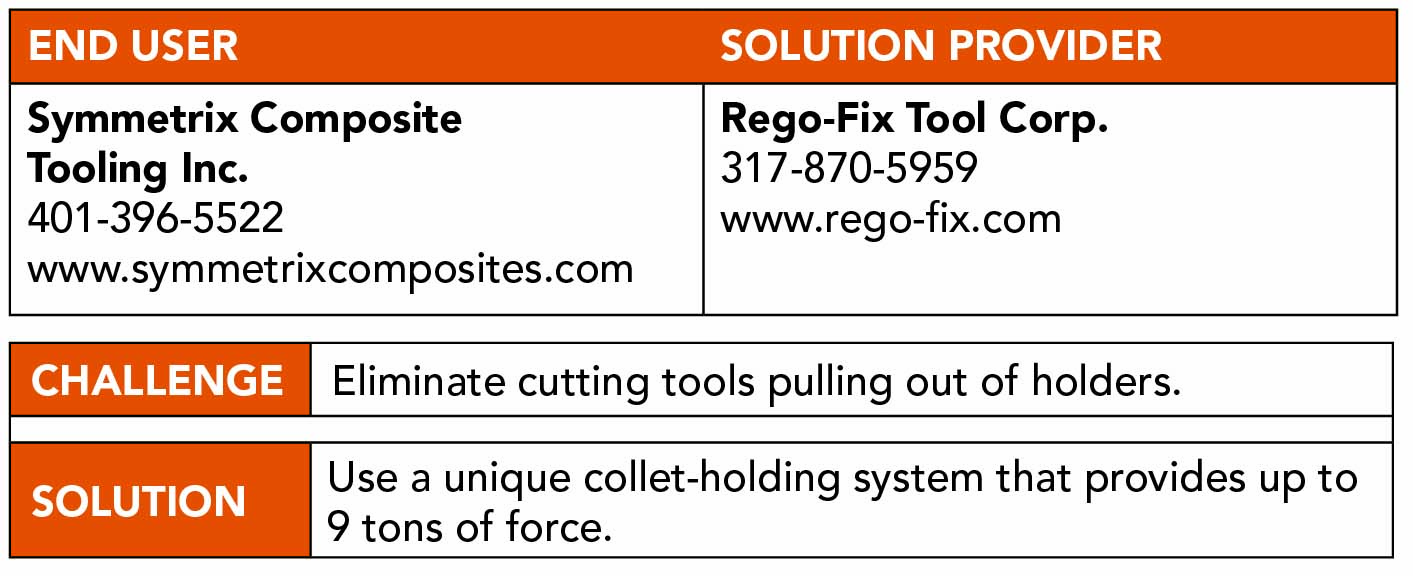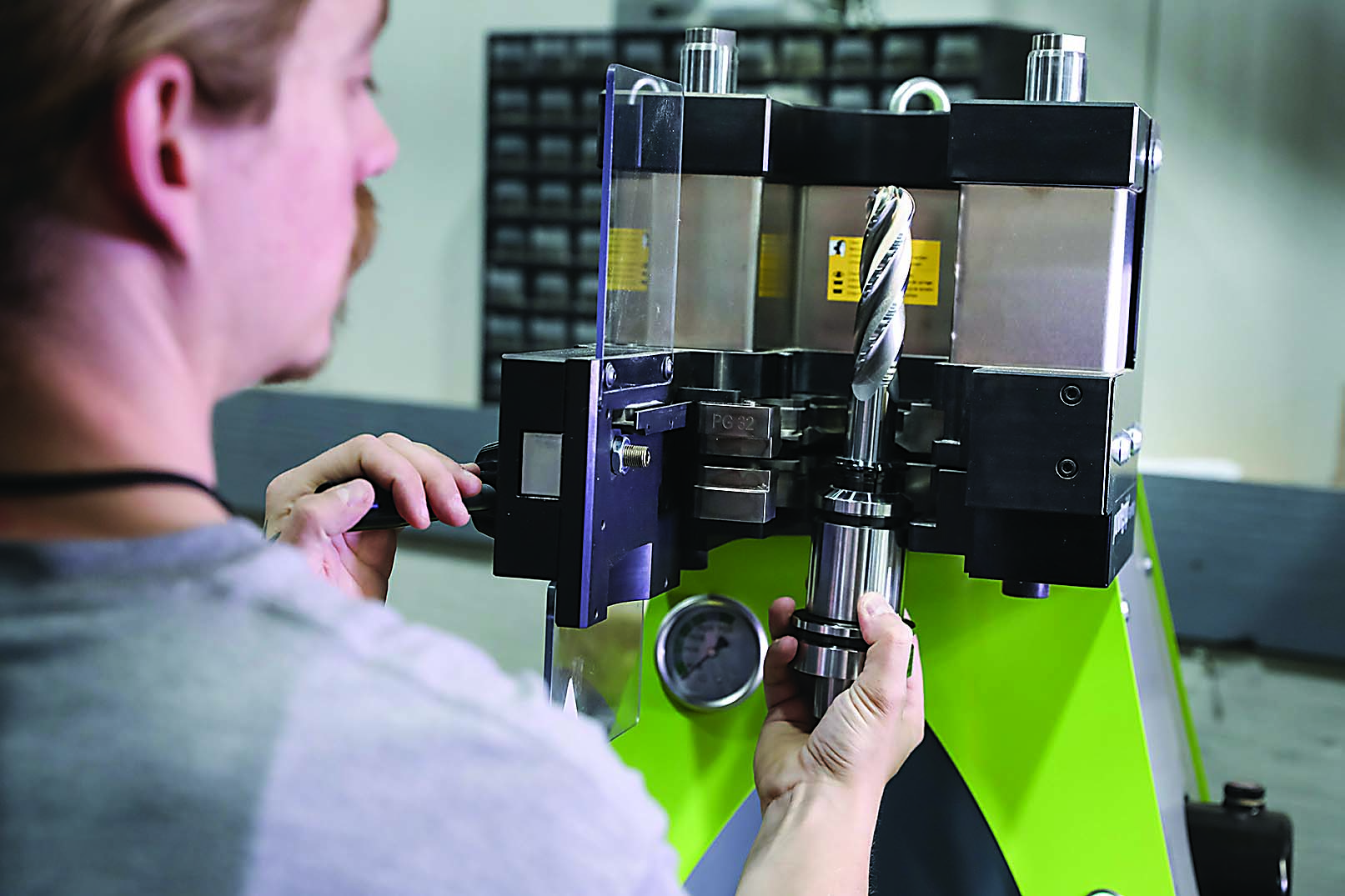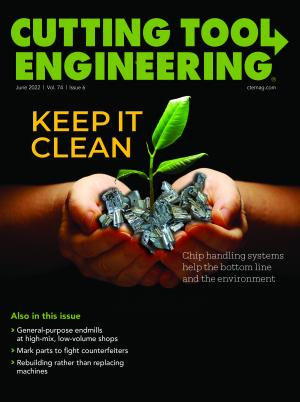John Barnitt, president of Symmetrix Composite Tooling Inc., said the reputation of his machine shop depends on the high precision and quality of the large-format tooling that the company produces for the composites industry. The Bristol, Rhode Island, shop focuses on perfection to prevent recurring errors, mistakes in geometry or flaws in tooling surfaces that transfer to molds and in turn to the final production parts for customers.
To achieve the best results, the shop combines advanced manufacturing technology with old-school craftsmanship. With five-axis machining, Symmetrix Composite Tooling shortens job lead times by weeks in most instances for customers in industries that include marine, architecture, aerospace, transportation and wind energy. Unfortunately, the density of the tooling paste that the shop works with proved to be a root cause of toolholding problems there.
The shop cuts thick sections of this material, running at 9,000 rpm spindle speeds and feeding at 1,200 m/min. (3,937 sfm), which generates a lot of stress on cutting tools and toolholders. As a result, Symmetrix Composite Tooling experienced cutting tool slippage, runout and vibration, which shortened tool life and affected surface finish quality.

When machining, solid-carbide endmills and ballnose cutters gradually would pull out of holders, often by an imperceptible amount but enough to affect toolpaths, part tolerances and surface finishes.
“During overnight cuts and even during the day, the tool would actually come loose, causing a different length from hundredths of a millimeter all the way to I’ve seen a full millimeter of slippage,” said Lead CNC Machinist Noah Maraziti. “It causes a big issue if we have a tool that’s wobbling back and forth as it’s trying to cut a path.”
In addition, toolholder runout caused vibration, which not only shortened tool life but — like the pullout — degraded part surface finishes, especially during final cut passes.
For Symmetrix Composite Tooling, cut times for one part can run as long as five days, and the shop relies heavily on its ability to machine parts unattended overnight. Unfortunately, the shop didn’t trust its toolholders for extended periods of lights-out machining and needed to resolve the problem. That’s when the business reached out to Whitestown, Indiana-based Rego-Fix Tool Corp. and acquired its powRgrip, or PG, collet-holding system.
The product from the toolholder manufacturer not only eliminated the issues of pullout, total indicator runout and vibration but allowed Symmetrix Composite Tooling to run at faster cutting speeds, which shortened part cycle times and extended tool life. With the PG, the shop confidently can run parts overnight or longer, with minimal if any intervention.
“We are comfortable with leaving the machine running by itself unattended for multiple days at a time — three, four days at a time,” Maraziti said.
The shop formerly used a typical nut and collet holder that he said could be inaccurate at times, mainly because of improper nut torque.
“With PG,” Maraziti said, “we eliminate the need for torque wrenches and get an accurate clamp every time.”
He sets up all the tooling and tracks tool wear and life so engineers can use the toolpath of a part to accurately predict when a tool needs to be changed.

“Previously, cutters lasted about one week, maybe two,” Maraziti said. “But with the PG, we’re getting up to four weeks per cutter. Getting the most cutting life is huge for us. It allows us to maintain more accurate cuts without changing tool diameters and tool lengths every other day because a tool is worn out. The Rego-Fix helps in a way with that just simply because it has a better grip on the tool. The tool isn’t getting as much wear, so it’s dulling in a lot less time.”
Rego-Fix Tool reports that the PG toolholding system relies on interference between the holder and collet to generate clamping force. Unlike other clamping systems that use heat or hydraulics to expand the toolholder, the PG uses the mechanical properties of the holder material to generate up to 9 tons of gripping force, with runout below 0.00254 mm (0.0001"). PG units take less than 10 seconds to press in a tool or remove it from a holder. Because the system uses no heat, tools can be used immediately after a tool change.
John Alexion, plant manager at Symmetrix Composite Tooling, said depending on how molds are made, they can be slated for limited use (direct tooling) for a single part, for three to 10 parts or for full production.
In addition to its Bristol location, Symmetrix Composite Tooling operates facilities in Statesville, North Carolina, and Minden, Nevada. Regardless of which location builds tooling, the results are exactly the same because the company replicates all its processes at each facility.
“We incorporated five-axis machining at our facilities not only to keep our costs in check but also our customers’ costs,” Alexion said. “Without that machining capability, all the shaping processes would have to be done manually and add considerably to our lead times. While our composite tooling will always require expert sanding and finishing by hand, the better the surface finish we achieve with the CNC machine, the less time we require for that manual work. This is why the PG tooling is so beneficial.”
It is this melding of advanced manufacturing and craftsmanship that allows Symmetrix Composite Tooling to distinguish itself from the competition.
Contact Details
Related Glossary Terms
- collet
collet
Flexible-sided device that secures a tool or workpiece. Similar in function to a chuck, but can accommodate only a narrow size range. Typically provides greater gripping force and precision than a chuck. See chuck.
- composites
composites
Materials composed of different elements, with one element normally embedded in another, held together by a compatible binder.
- computer numerical control ( CNC)
computer numerical control ( CNC)
Microprocessor-based controller dedicated to a machine tool that permits the creation or modification of parts. Programmed numerical control activates the machine’s servos and spindle drives and controls the various machining operations. See DNC, direct numerical control; NC, numerical control.
- mechanical properties
mechanical properties
Properties of a material that reveal its elastic and inelastic behavior when force is applied, thereby indicating its suitability for mechanical applications; for example, modulus of elasticity, tensile strength, elongation, hardness and fatigue limit.
- shaping
shaping
Using a shaper primarily to produce flat surfaces in horizontal, vertical or angular planes. It can also include the machining of curved surfaces, helixes, serrations and special work involving odd and irregular shapes. Often used for prototype or short-run manufacturing to eliminate the need for expensive special tooling or processes.
- toolholder
toolholder
Secures a cutting tool during a machining operation. Basic types include block, cartridge, chuck, collet, fixed, modular, quick-change and rotating.
- toolpath( cutter path)
toolpath( cutter path)
2-D or 3-D path generated by program code or a CAM system and followed by tool when machining a part.
- total indicator runout ( TIR)
total indicator runout ( TIR)
Combined variations of all dimensions of a workpiece, measured with an indicator, determined by rotating the part 360°.



